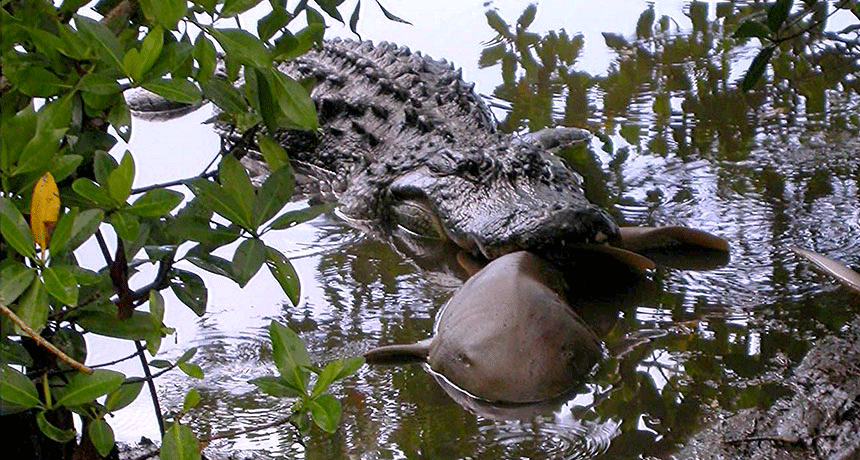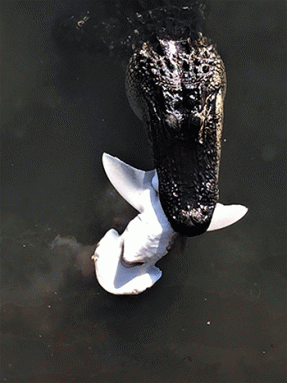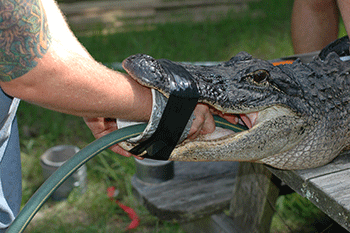Alligators aren’t just freshwater animals
These reptiles have been caught in salty waters snacking on shark

This alligator was spotted eating a nurse shark in a wildlife refuge on Sanibel Island, Fla., in August 2003. The sighting helped to confirm that shark is part of some gators’ diets.
COURTESY OF U.S. FISH AND WILDLIFE SERVICE J.N. "DING" DARLING NATIONAL WILDLIFE REFUGE
Share this:
- Share via email (Opens in new window) Email
- Click to share on Facebook (Opens in new window) Facebook
- Click to share on X (Opens in new window) X
- Click to share on Pinterest (Opens in new window) Pinterest
- Click to share on Reddit (Opens in new window) Reddit
- Share to Google Classroom (Opens in new window) Google Classroom
- Click to print (Opens in new window) Print
Hungry alligators don’t just stick to freshwater. These crafty reptiles can live quite easily in salty waters (at least for a bit) where they’ll find plenty to eat. Their diet includes crabs and sea turtles. A new study adds sharks to their menu.
“They should change the textbooks,” says James Nifong. He’s an ecologist with the Kansas Cooperative Fish and Wildlife Research Unit at Kansas State University in Manhattan. He has spent years documenting the diet of estuarine gators. (An estuary is where a river meets the ocean.)
Nifong’s most recent discovery is that the American alligator (Alligator mississippiensis) eats at least three species of shark and two species of rays. (Those last animals are essentially flattened sharks with “wings.”)
Wildlife biologist Russell Lowers works at Kennedy Space Center in Cape Canaveral, Fla. A paper he coauthored with Nifong in the September Southeastern Naturalist describes what they learned about the gator’s appetite for shark.

Lowers actually captured a female gator with a young Atlantic stingray in her jaws. This was near Cape Canaveral. He and Nifong gathered several other eyewitness accounts. One U.S. Fish and Wildlife Service worker, for instance, spotted a gator eating a nurse shark in a Florida mangrove swamp. That was back in 2003. Three years later, a birder photographed an alligator eating a bonnethead shark in a Florida salt marsh. A marine turtle specialist that Nifong sometimes works with saw gators consuming both bonnethead and lemon sharks in the late 1990s. And after the new paper was published, Nifong turned up yet another report of a gator eating a bonnethead shark, this time off Hilton Head, S.C.
All of these snacks required gators to venture into saltwater.
Figuring out the menu
Because alligators don’t have any salt glands, “they’re subject to the same pressures as me or you when being out in saltwater,” Nifong says. “You’re losing water, and you’re increasing salt in your blood system.” That can lead to stress and even death, he notes.
To deal with salt, Nifong explains, gators tend to just go back and forth between saltwater and freshwater. To keep salty water out, they can shut their nostrils and close off their throat with a cartilage-based shield. As they eat, alligators tip their heads up to let the saltwater drain out before gulping down their catch. And when they need a drink, gators can tip their heads up to catch rainwater or even gather freshwater from a layer floating atop saltwater after a rain shower.
Nifong has spent years catching hundreds of wild gators and pumping their stomachs to see what they had swallowed. That field work relies “on electrical tape, duct tape and zip ties,” he says. And it showed that the list of what’s on a gator’s menu is pretty long.
To snag an alligator, he uses a big blunted hook or, if the animal is small enough, he just grabs it and hauls it into the boat. Next, he puts a noose around its neck and tapes the mouth shut. At this point, it’s relatively safe to take body measurements (everything from weight to toe length) and to get blood or urine samples.

Once that’s out of the way, the team will strap the gator to a board with Velcro ties or rope. Now it’s time to untape the mouth. Someone quickly inserts a piece of pipe in the mouth to hold it open and tapes the mouth around the pipe. That pipe, Nifong says, is there “so they can’t bite down.” That’s important, because next someone has to stick a tube down the gator’s throat and hold it there to keep the animal’s throat open.
Finally, “we fill [the stomach] up with water very slowly so we don’t injure the animal,” Nifong says. “Then we do basically the Heimlich maneuver.” Pressing down on the abdomen forces the gator to give up its stomach contents. Usually.
“Sometimes it goes better than other times,” he reports. “They can just decide to not let it out.” In the end, the researchers carefully undo all their work to let the gator loose.
A broad and varied diet
Back in the lab, Nifong and his colleagues tease out what they can from those stomach contents. They also look for more clues about what the animals eat from samples of their blood. Gators are eating a rich marine diet, those data show. Meals may include small fish, mammals, birds, insects and crustaceans. They’ll even eat fruit and seeds.
Sharks and rays didn’t show up in these studies. Nor did sea turtles, on which gators have also been spotted munching. But Nifong and Lowers speculate that’s because the gator gut digests the tissues of those animals very quickly. So if a gator had eaten a shark more than a few days before being caught, there would be no way to know.
What alligators eat isn’t as important a finding as was the discovery that they regularly travel between saltwater and freshwater environments, Nifong says. These dual dining zones occur over “a wide variety of habitats across the U.S. Southeast,” he notes. That’s important because these gators are moving nutrients from rich marine waters into poorer, fresh waters. As such, they may be having a larger effect on estuarine food webs that anyone had imagined.
For instance, one prey item on the alligator menu is blue crab. Gators “scare the bejesus out of them,” Nifong says. And when gators are around, blue crabs decrease their predation of snails. The snails might then eat more of the cordgrass that forms the base of the local ecosystem.
“Understanding that an alligator has a role in that kind of interaction,” Nifong points out, is important when planning conservation programs.







